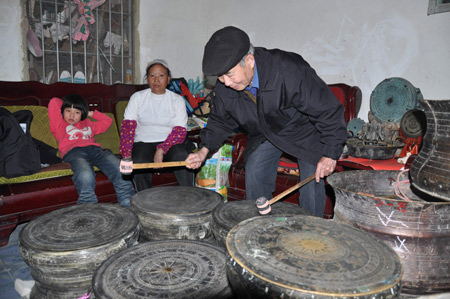Heritage
Drumming up interest
Updated: 2011-04-13 07:55
By Liu Xiangrui (China Daily)
|
 Holding 15-25 kg bronze drums with their teeth, villagers from Donglan county, Guangxi Zhuang autonomous region, perform bronze drum dances. Photos by Liu Xiangrui / China Daily |
Cheers from the crowd and drumbeats vibrate around the valley when Huang Jianmin and his fellow male villagers lift the heavy bronze drums with their teeth, while beating them with drumsticks in both hands and dancing.
"In my village, it's hard to make friends if you cannot play the bronze drums. We've been learning to do so since we were young," says 41-year-old Huang, adding it hurt at first to lift the 15-25 kg drums just with his teeth.
As part of the First International Bronze Drum Festival, held in early April, in Donglan county, Guangxi Zhuang autonomous region, the drum performance celebrated the customs of the Zhuang and Yao people, who comprise 90 percent of Donglan's 270,000 population.
It is estimated that more than 600 ancient bronze drums are still in use in Donglan; while the bronze drum tradition of the Zhuang ethnic group was listed as a first category national intangible cultural heritage in 2006. Donglan, meanwhile, was recognized by the Ministry of Culture as "home to the tradition and art of bronze drums".
Legend has it that Miluotuo, the ancestral mother and goddess of the Zhuang and Yao people, made the first bronze drums and gave them to her sons to scare off beasts and evil spirits, Huang says.
There are 18 drums in Huang's village of 38 households, owned by two formerly wealthy families.
"When the new year arrives, they start beating the drums and villagers come from all over to join in," Huang says.
|
 Wei Wanyi, 83, plays bronze drums for visitors. He has collected more than 20 bronze drums and stores them in a special room in his house. |
In his village, a Yao enclave, bronze drum performances are a vital part of festivals like their new year celebration on the 29th day of the fifth lunar month, marriages, birthdays, and house-warming parties. They are also played to herald the sowing and harvesting of corn and soybean crops.
Bronze drums are also props for games, in which men and women have small wagers for handkerchiefs and cigarettes. "The only rule is the one who can keep on drumming fast is the winner," Huang explains.
Bronze drums are regarded as family heirlooms. Wei Wanyi, an 83-year-old retired teacher, has more than 20 and stores them in a special room in his house.
He started adding to his original collection of four bronze drums in 1967, when he found three drums at a recycling company and bought them for 180 yuan ($27.50), a year's income for the family then.
He also traveled to nearby Yunnan province to collect bronze drums, bought from poor rural families at a markdown.
Wei plays his drums at home whenever he is in the mood and is always keen to perform.
"Their sound puts me in a good mood," Wei says.
In recent years, bronze drum performances have become fashionable and he has appeared at events such as the Golden Rooster Awards for Films and the Ancient Chinese Music Show, in Shanghai.
Bronze drum culture in southern China and bordering countries like Myanmar, Laos and Vietnam has evolved, from being a part of daily life, to being seen as sacred, says Chen Yaoling, a collector of bronze drums.
In Chen's private museum in downtown Donglan, there are more than 100 bronze drums of various shapes and styles, with the oldest dating back to the Han Dynasty (206 BC-AD 220).
The scenes on the drums usually describe legends or historical events, Chen says.
"They used to have many functions, such as worship, amusement and communication during war," Chen says. "Only very wealthy families could afford them and the poor used to share."
The bronze drums of Donglan were under threat in the 1950s when China launched the "Great Leap Forward", which called on people to provide metal to the State, says Huang Xianchang, the county mayor.
"But people cherished (their drums) so much they bought other metal materials so they wouldn't have to hand in their drums."
E-paper

Han me downs
Traditional 3,000-year-old clothes are making a comeback.
Reaching out
Fast growth fuels rise in super rich
Chinese tourists spend more
Specials

Big spenders
More mainland tourists are expected to spend money on overseas travel this year.

Rise in super rich
Report cites rising property prices, gdp as key drivers of increasing number of chinese millionaires.

Reaching out
Condom makers are stepping up their presence in smaller cities to boost sales
